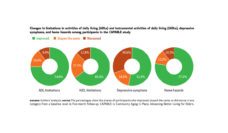A small proportion of the American Medicare population consists of migratory elders. Making up around 5.5% of Medicare beneficiaries, these elders migrate seasonally, often traveling between two homes. The most common type of seasonal migrators are ‘snowbirds’ who travel south in the winter to warmer states and north in the summer. As a result of their migratory nature, snowbirds often receive medical attention in two sites, creating complexities in medical care.
Little is known about the patterns and health needs of traveling Medicare beneficiaries. Dr. Jeffery and her team conducted a study of 1.5 million persons looking to identify seasonal migrators, and describe the type of care received over the course of 2011-2012. The researchers reported the types of services that migrators used in each seasonal home while exploring the effects that primary health care access has on emergency department (ED) visitation rates.
Each beneficiary’s permanent address on file was taken from the Medicare data. Each medical claim was connected to county data where the patient received care. The distance between the county where a beneficiary sought health care and their permanent address on file was measured. Data on four measures of health care were collected: primary care treatable (PCT) emergency department visits, total ED visits, number of inpatient hospitalization days, and number of visits with specialists.
Importantly, snowbirds had higher rates of emergency department visits and specialist visits than non-migratory groups.
Snowbirds made up a little over 4% of the Medicare population studied and were more likely to be White compared to other Medicare beneficiaries. Importantly, they had higher rates of ED visits and specialist visits than non-migratory groups.
Medicare beneficiaries are the most common group of adults to visit emergency departments. Studies have found that ‘inappropriate’ ED visits are in part due to the perceived convenience of accessing emergency departments, and as seasonal visitors, snowbirds may not have access to local primary care providers. ED visits are generally more expensive than visiting a primary care providers. Indeed access to local primary care reduced rates of ED visits and ED visits for all migratory groups.
Snowbirds’ rates of ED visits should be lower, given that on average they have higher education, higher incomes, and are healthier. The authors suggested that snowbird rates of PCT ED visits could be reduced by more than 50% with access to local primary care. ED visitation rates could be lowered further perhaps by telehealth services. Snowbirds will continue to migrate, but they need two nests that have access to primary care services to make the journey most safely.
Feature image: Daniel Oines, Untitled, used under CC BY 2.0













